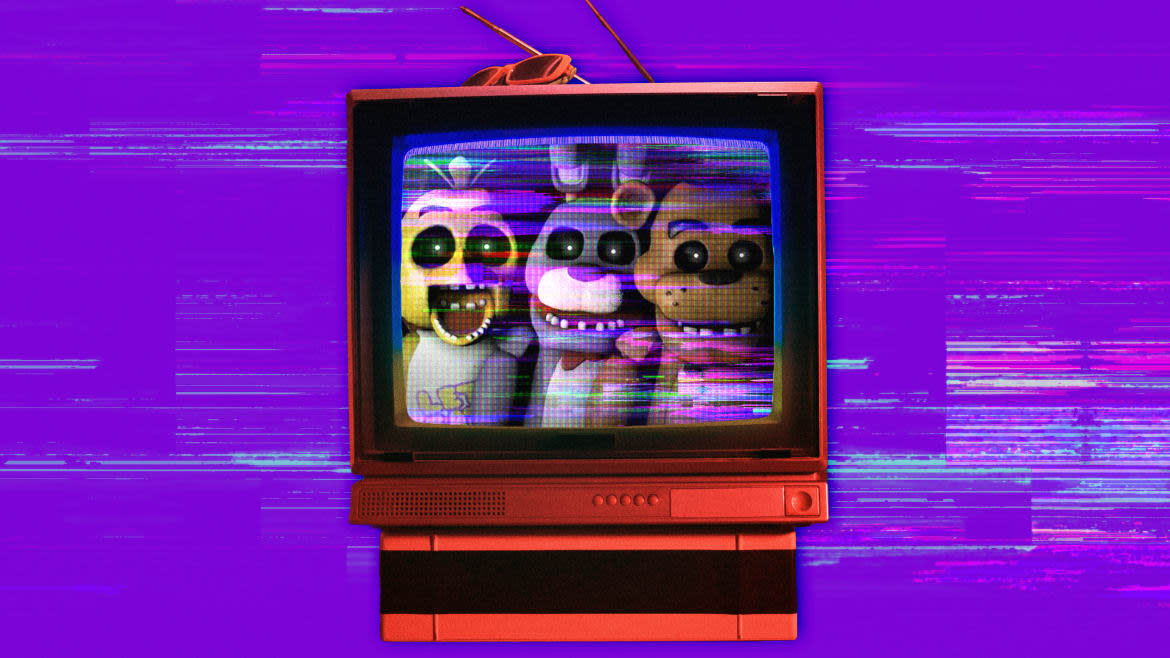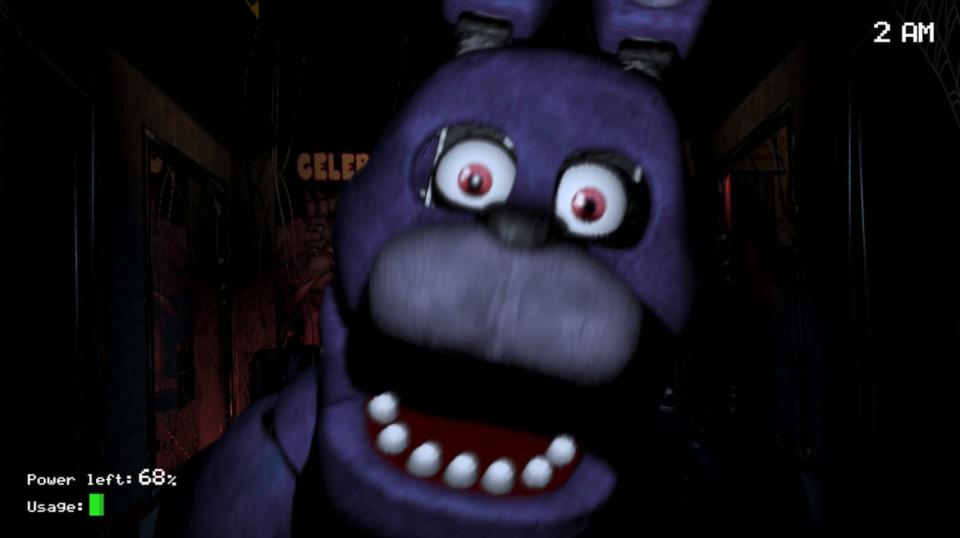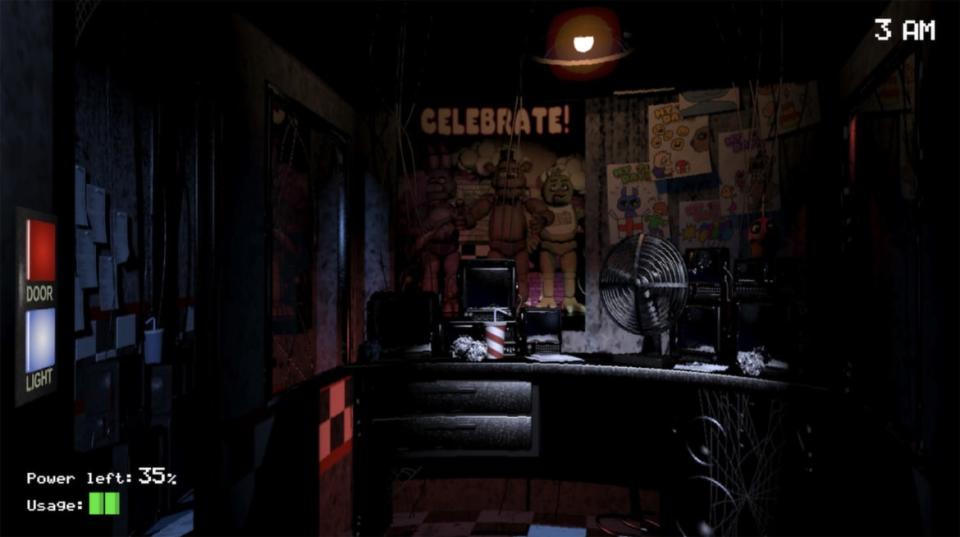A ‘Five Nights at Freddy’s’ Movie Could Never Compare to the Games

- Oops!Something went wrong.Please try again later.
- Oops!Something went wrong.Please try again later.
That laughter you hear? It’s not some animatronic bear lurking in the darkness, waiting to scare the snot out of you. It's the sound of a fanbase vindicated. Despite widely withering reviews (including this one from The Daily Beast, and, uh, also this one) and the simultaneous opportunity to stream the film on Peacock, the Five Nights at Freddy’s movie scared up big business over the weekend, earning an unexpectedly robust, record-breaking $78 million in American theaters.
It really shouldn’t be surprising that the movie opened huge. After all, it’s the latest building block of a true media empire: a hit video game series that just keeps expanding into sequels, spinoffs, novels, fan art, and enough merchandise to fill every square inch of an abandoned family fun center. Five Nights at Freddy’s has an extremely loyal, protective following. And the film caters to that crowd with a fairly faithful adaptation of the games' haunted-pizzeria lore. It didn't really need to be “good” or even particularly scary to sell a bunch of tickets. It just needed to repackage the things people already love about FNAF.

There’s one aspect of the source material the movie didn’t preserve, though, and that’s the nerve-shredding experience of actually playing the games. Replicating that was always going to be a tall order, and hence probably never a priority for the filmmakers. A truly faithful adaptation would be an exercise in extreme minimalism, set in a single room and focused mostly on a character studying video monitors for signs of trouble. Not shockingly, Hollywood opted for something a little more narratively conventional, building actual characters and a plot around developer Scott Cawthon’s original, bare-bones premise.
But it’s that ruthless simplicity that gave the games—especially the first one—their addictively terrifying charge. Long before fans began to pore over Easter eggs in search of clues to the overarching backstory of Freddy Fazbear’s Pizzeria, players submitted themselves to the cruelly narrow parameters of the gameplay. The malevolently perverted Chuck E. Cheese-like setting may have been the hook of Five Nights at Freddy’s, and the key to its Hot Topic immortality. But it was how the game cornered you in that space, limiting your vantage and defenses, that made it such a uniquely scary piece of 21st-century horror.
In its barest logline, the movie recreates the setup of the first Five Nights at Freddy’s game. In the 2014 original, you took control of a security guard, newly hired to the graveyard shift at an abandoned restaurant that shuttered in the ’80s. Overnight, the establishment’s animatronic entertainers—Freddy, Bonnie, Chica, and the velociraptor-fast Foxy—spring to life, making their way across the building to the security room where you're stationed. The objective is simple: Fend off the robots through sheer vigilance, staying alive from midnight to 6 a.m.
The ‘Five Nights at Freddy’s’ Fandom Is Unlike Any Other
Making the player feel powerless is one of the key tenets of survival horror. Resident Evil, which popularized the genre, winnowed ammunition and resources down to a sadistic scarcity, forcing you to carefully conserve and often choose flight over fight. Years later, games like Outlast would take combat out of the equation entirely, demanding that players rely on only a flashlight and their wits.
FNAF pushed that idea to a new extreme of diabolically provoked helplessness. Its innovation was to disable almost all player movement: You can’t fight, you can’t run, you can’t hide. If there’s a dark joke, it’s that you're as immobile as normal animatronics are. The game takes the illogical paralysis of a nightmare and makes you play through it.
In Five Night at Freddy’s, you’re chained to your surveillance post, with a series of strictly defensive tools at your disposal. You can toggle through a grid of security monitors, each offering a grainy view of one of the other rooms in the building (along with unnerving glimpses of the animatronics frozen in fearsome position, waiting for you to look away so they can move again). You can flip on the lights in the hallway leading to your office, occasionally catching one of the robots about to stomp in on you. You can slam the doors shut to keep the monsters out. But all this drains the power, and if the power runs out, you’re a sitting duck, vulnerable to a walking duck and her enormous friends.

Doing anything brings you closer to certain doom. But so does doing nothing. You learn to spot the warning signs—the shadow of rabbit ears on the wall, the glint of mechanical eyes in the dark—or to hear them. FNAF is an ingenious sonic experience, too, forcing players to listen closely for footsteps or warbles. That’s all part of the game’s calculated assault on the nerves: You have to almost lean in close to catch the audible clues that danger is approaching, but that also makes you more susceptible to the rude sting of volume that accompanies the instant-game-over attacks by Freddy and co. Getting through each night basically requires learning their patterns, but they also escalate in speed and intensity, so that by night five, one wrong look at the camera feed or failure to hit the lights will result in a very nasty photobomb.
Jump scares are a big part of what made Five Nights at Freddy’s popular: The game became hit streaming fodder, as Twitch personalities broadcast their own yelping alarm at each spring-loaded appearance by the animatronics; those too nervous to actually subject themselves to the game's mechanics could still witness someone pissing their pants over a live feed. But the deeper dread of the game lay in the anticipation of those scares; you're trying to avoid the jolt. And like an expertly constructed funhouse, FNAF works hard to give you the willies during the pockets of nervous quiet between the scares. Every glimpse of the animatronics somewhere they shouldn't be does the trick.
The ‘Five Nights at Freddy’s’ Movie Isn’t Worth a Single Evening
What the game is really about is visibility: what you can see, what you can't, and the danger in between. It’s truly a surveillance simulator, in the sense that it forces you to look, to confront the danger by bravely searching for it. The only way to stop some of the animatronics is to literally lay eyes on them—which is to say, freeze them in place by locating them on the cameras. But watching one place can leave you open to an attack from the other; the menace often lies in the offscreen space, that area just beyond your sightline. The real horror of FNAF is in the tension between the primal urge to look away from something bad and the imperative to keep looking, nerves be damned.
There are movies that have played with similar ideas. The Paranormal Activity series leaps to mind, thanks to its locked camera angles, limited vantages, and nightly escalation of terrors. Like the FNAF games, those films map a visual space on your mind and increase the fear just with the promise of something more intense filling it. A found-footage take on FNAF could have worked, maybe. One could also imagine a better big-screen version of this material from Jeremy Saulnier, whose Green Room trapped characters inside a small space and made them think around the enemies circling their castle, or from David Robert Mitchell, whose It Follows did heart-pounding marvels with the slow advance of something wicked in the distance.
Then again, maybe this is just another case of a video game adaptation losing something in the transition out of an interactive medium. Any big-screen version is going to sacrifice the crucial component of player involvement. In the game, it’s you choosing to hit that light switch, or open that door, or switch to that video feed, or lower that monitor when you hear the deep breathing of something there with you in the room. It’s you who has to choose to look. No movie, even a much better one than Five Nights at Freddy’s, could have the same effect.
Get the Daily Beast's biggest scoops and scandals delivered right to your inbox. Sign up now.
Stay informed and gain unlimited access to the Daily Beast's unmatched reporting. Subscribe now.

